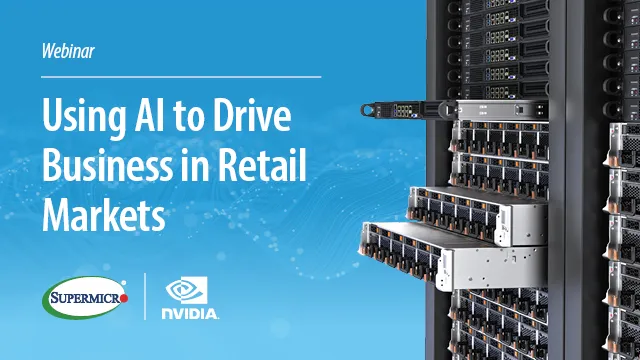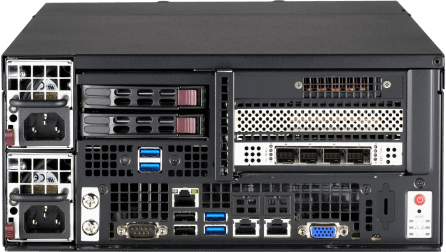Accelerate Retail Transformation with AI-Powered Solutions
Retail is at the cusp of transformation, and AI is the catalyst. Supermicro AI-powered solutions are revolutionizing the industry, enabling retailers to drive innovation, enhance customer experiences, and achieve strategic growth. Powered by advanced machine learning algorithms and deep neural networks, our Retail AI platforms leverage and integrate NVIDIA’s AI software and GPU hardware to provide a best-in-class solution.

“Retail AI is happening now – 64% of large retailers are already using AI with 80% of them deploying 3 or more use cases”
“In retail and consumer packaged goods, the potential impact [from generative AI] is…significant at $400 billion to $660 billion a year”
Personal Shopping Advisor
Improving Customer Experience and Driving Growth
- Personalized Recommendations
- Efficient Navigation
- Real-Time Support
AI-powered shopping advisors deliver personalized recommendations and experiences to consumers, improving customer ratings, removing sales friction, and boosting revenue for retailers.
“92% of retailers say they are investing in AI to improve shopping experiences”
86% of all retailers want to use generative AI to enhance their customers’ experiences.1
66% of survey respondents chose personalized recommendations as the top generative AI use case2.
Retail Loss Prevention
Enhancing Security and Inventory Management
- Real-Time Monitoring
- Facial Recognition
- Predictive Behavior Analysis
AI helps retailers better understand and track their inventory and increase the effectiveness of security solutions designed to prevent product shrinkage.
“Retail product shrinkage is a $142B per year challenge, with over 65%…due to theft”
Organized retail crime is an epidemic, a growing problem that AI can help mitigate. In the absence of AI solutions, we would be in an even worse problem than being seen today.3
Computer vision AI delivers insights that enable retailers to see and solve complex challenges in real-time to significantly reduce losses and improve margins by up to 20 percent.4
Store Analytics
Real-Time Insights for Operational Excellence
- Predict and Prevent Stockouts
- Optimize Merchandising through Planogram Performance Assessments
- Streamline Store Operations
AI revolutionizes retail operations by transforming store analytics, offering predictive capabilities to prevent stockouts, optimizing merchandising strategies through precise planogram performance assessments, and streamlining store operations with real-time data insights.
“[AI in inventory management] can optimize stock levels, reduce carrying costs, minimize deadstock, and cut down on the costs associated with stockouts”
In a retail store, layout isn’t just about improving navigation. It’s about optimizing your space for the products you want to sell and the customer experiences you want to create.5
Based on analytics, make the most of scarce store staffing resources by directing them to their highest and best use in real-time, thus reducing labor costs while improving customer experience.6
Employee Assistance
Streamlining Workflows and Maximizing Productivity
- Virtual Assistants and Chatbots
- Visual Search
- Balancing Employee Workload
- Learning and Development
- Data-driven Decision Making
AI modernizes the employee experience, simplifies workflow processes, and provides dynamic guidance for a more efficient work environment.
“Annual employee turnover among frontline retail workers has been at least 60 percent for a long time”
Store associates are taking on more responsibilities, spending as much as 74% of their time on activities unrelated to checkout.7
Leverage an employee co-pilot to harness vast institutional knowledge providing expert, in-context instructions and best practices.8
Intelligent Supply Chain
Optimizing Operations and Ensuring Connectivity
- Warehouse Simulation
- Efficiency in Inventory Management/
Warehouse analytics - Enhanced Demand Forecasting
- Package handling and route optimization
- Last-mile Delivery
- Sustainability
AI optimizes supply chains by predicting demand, managing inventory levels, and enhancing efficiency, ensuring retailers stay seamlessly connected.
“Too much back-of-house inventory, for example grocery overstocking, often leads to product wastage if employees take what they can see, rather than what might expire first”
Implement digital twin simulations to increase supply chain efficiencies over time by leveraging predictive methodologies that become more accurate with real-world testing and responses.9
Over 53% of total delivery costs come from last mile delivery costs, making predictive AI for route optimization a critical success factor.10
Omnichannel Management
Delivering Seamless Customer Experiences
- Unified Customer Experiences
- Predictive Merchandising
- Recommendation Engines/
E-Commerce - Conversational AI for Customer Sentiment Analysis
- Augmented, virtual, and mixed reality
AI helps retailers deliver seamless customer experiences across multiple digital and in-person touchpoints, reducing frustration and maximizing revenue.
“79% of consumers expect brands to have a consistent message and appearance across all the digital platforms they interact with”
Marketers can leverage their vast amounts of data to identify patterns and anticipate future customer behaviors, sales trends, and marketing outcomes.11
Over 33% of survey respondents say they would use generative AI to try on clothes virtually.12
Using AI to Drive Business in Retail Markets
Are you curious how AI can transform retail experience? From optimizing inventory management to personalizing customer interactions, AI is revolutionizing core aspects of the retail industry today. Learn how AI is being used in modern retail environments for advancing business and delivering exceptional customer experiences.
Join our webinar with industry experts from Supermicro and NVIDIA as we explore:
- Key use cases for AI in retail
- How Supermicro and NVIDIA are enabling AI-powered retail experience with a broad range of solutions
- Key advantages of our Retail AI platforms and how you can get started now










